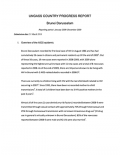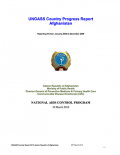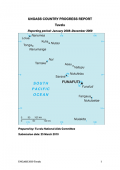What's New
Displaying results 4021 - 4030 of 4914

Resource | Publications,
Brunei Darussalam recorded its first local case of HIV in August 1986 and has had cumulatively 56 cases in citizens and permanent residents up till the end of 2009. Out of these 56 cases, 19 new cases were reported in 2008‐2009, with 2009 alone representing the highest annual increase with 11 new cases and a total of 8 new cases reported in 2008. As of the end of 2009, there are 34 persons known to be living with HIV in Brunei with 2 AIDS‐related deaths recorded in 2008‐9.

Resource | Publications,
The first HIV infection in Sri Lanka was reported in 1987. Since then, a total of 1196 HIV infections and AIDS cases have been cumulatively reported in the country. There has been a steady increase in the number of reported cases over the years, in part due to the increase in HIV testing facilities and the availability of antiretroviral treatment.

Resource | Publications,
This report has been prepared under the leadership and coordination of the National AIDS Authority (NAA) and with broad participation of all key stakeholders in Cambodia's response to HIV and AIDS. The consultative process involved key government ministries and departments, civil society, including representation of people living with HIV and of most-at-risk populations, and development partners.
The report demonstrates Cambodia's success in building one single comprehensive system to track the HIV epidemic and to monitor and evaluate the national response to it. Although new data has not yet become available for all the 25 UNGASS indicators, Cambodia is this year able to present data against several indicators that could not be reported in previous rounds.

Resource | Publications,
National STD/AIDS Programme (NASP) of the Ministry of Health and Family Welfare, Government of Bangladesh, provided coordination and leadership support to the process of preparation of UNGASS 2010 Bangladesh Country report. Report preparation was a joint effort of key stakeholders from government, civil society organizations (particularly organizations working on HIV prevention and care), UN agencies and other development partners. There were several consultations, one on one and in groups, to involve all national key stakeholders in the process of UNGASS report preparation.

Resource | Publications,
The Ministry of Public Health (MoPH) of the Islamic Republic of Afghanistan is happy to submit its first United Nations General Assembly Special Session (UNGASS) country progress report on HIV and AIDS to add to the richness of global strategic information in response to HIV and AIDS.

Resource | Publications,
The preparation of Mongolia’s 2010 Country Progress report, led by the National Committee on HIV/AIDS (NCA), followed an inclusive and consultative process. The main stakeholders in Mongolia’s national response were closely involved in the report’s development and comprised of government institutions, development partners, and civil society organizations, including people living with HIV (PLHIV).

Resource | Publications,
The National Composite Policy Index (NCPI) data submitted by countries was validated for internal consistency and completeness of the response by UNAIDS/Geneva. Illogical values were corrected; countries were contacted in cases of substantial missing data and multiple, non-consolidated NCPI submissions. The PDF files posted contain the validated NCPI data.

Resource | Publications,
This report was compiled by the Tuvalu National AIDS Committee (TuNAC), a body which comprises representatives of government agencies and non-governmental organisations (NGOs) that are actively involved in reducing the vulnerability of people in Tuvalu to HIV and AIDS, as well as other health and community risks. All members of TuNAC were actively involved in preparing and reviewing the report.

Resource | Publications,
The 2008/09 Progress Report of the National Response to the Declaration of Commitment on HIV/AIDS (UNGASS) was prepared by the National STD/AIDS Control Programme (NSACP) of Ministry of Healthcare and Nutrition and several stakeholders using a participatory method during November 09 to March 2010. An initial meeting with the participation of several stakeholders was held to review the 2010 guidelines and identify the process for the preparation of the report. A technical working group was nominated to undertake the responsibility of the process and writing the report. Two workshops were held to introduce and train the government sector and civil society organizations (CSO) to complete National Composite Policy Index - Part A and Part B respectively. The vetting meeting was held in March for consensus of the document and thereafter finalized.

Resource | Fact Sheets,
In February 2010, there were 130 new HIV Ab seropositive individuals confirmed by the STD/AIDS Cooperative Central Laboratory (SACCL) and reported to the HIV and AIDS Registry (Table 1). This was a 177% increase compared to the same period last year (n=47 in 2009) [Figure 1].





